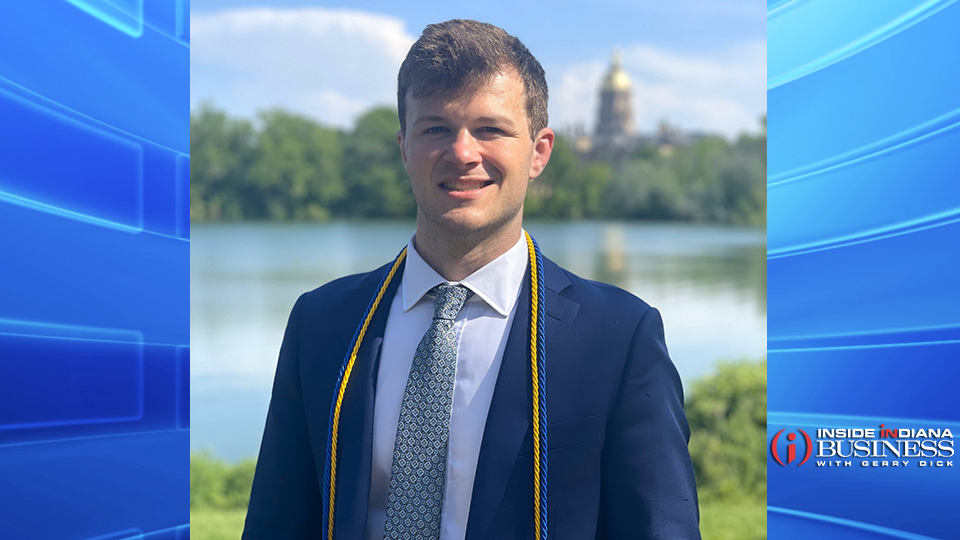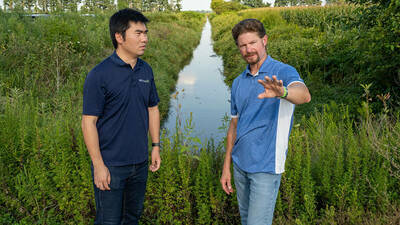Solvion Engineering licenses wastewater research from Notre Dame for product development
Subscriber Benefit
As a subscriber you can listen to articles at work, in the car, or while you work out. Subscribe Now
South Bend-based startup Solvion Engineering has licensed a novel brine cleaning solution from the University of Notre Dame.
Co-invented by Dorini Family Professor for Energy Studies Tengfei Luo and Brandon Ashfeld, a professor of organic chemistry, the patent-pending technology uses a proprietary solvent to extract clean water from high salt content water.
Motivated by the burgeoning scarcity of water resources across the globe and the Flint Water Crisis in Michigan, Ashfeld and Luo partnered up to take a cross-disciplinary approach to wastewater management.
“Seeing something so dramatic, so close to home, it just seemed ridiculous that a major metro area within the United States could be running into these types of water issues where we’re severely impacting the health of residents,” Ashfeld said. “Tengfei has been working in this area for a long time, so it became a very natural synergy between his group and mine in terms of leveraging science and engineering applications to more broadly impact specific issues.”
A byproduct of fracking, oil production, lithium mining and certain types of chemical manufacturing, high salt content wastewater, or brine water, can harm the environment and represents a wasted resource, especially in water-scarce areas.
Solvion CEO Brendan Ryan mentioned that the company is planning to scale up solvent production, create a demonstrator prototype and eventually bring the technology into industrial plants.
All water-based process industries could benefit from Solvion’s novel method, Ryan said, and the company has identified the oil and gas industry as the most viable earliest adopters of the technology with the biggest impact.
“After them, it could be used for chemical and agricultural purposes. In those cases, we can be put in the loop with a process that needs to recapture all the reagents that might be re-used in the chemical process,” Ryan said. “Further down the line there’s desalination, which is large-scale cleaning of water in order to reach municipal purposes, like getting it back to drinking water.”
Solvion’s product is both the machine and the solvent, Ryan explained. The company is able to customize the machine to meet customer needs. Ryan sees the product being added to the backend of any small or industrial-scale wastewater processing.
“In oil and gas fracking, they are removing the oil and gas. After a certain point, they stop removing the oil and gas and they choose to throw it away,” Ryan said, “Instead of transporting it and throwing it away, our machine would be on site, optimized to run at the lowest energy possible, at the exact throughput.”
The resulting clean water can be reused in the front end of these processes, eliminating millions of dollars in water costs. The potable water could alternatively be dumped safely with no regulatory consequence since all salts would have been removed.
While Ryan is currently the only full-time employee, Ashfeld and Luo have an equity stake in the company and serve on the board along with other folks from Notre Dame’s IDEA Center. During his MBA program, Ryan set up the business plan, technology roadmap, applied for grants and raised funds for the company.
“Our fundraising target is $200,000. We’re in the pilot phase from now through next year; we’re looking for two to four companies to be a part of that,” Ryan said. “It entails both running samples on a small version of our system and building out a larger, small-scale system.”
During his time at Notre Dame, Ryan and his class were presented with several research ideas for commercialization purposes, the wastewater market caught his attention.
“The more I learned about the wastewater market, the more I saw this coming in line with a big energy problem and demand of industries,” Ryan said. “The other ideas were across different technologies but I saw this as the best technology and the best market.”
Ryan, originally an engineer and looking to transition further into leadership, decided on business school to learn the ethical side of business. The tagline for the Mendoza College of Business at Notre Dame, “Grow the good in business,” aligned with his ambitions. He also wanted to be in school at the same time as his little sister, who was in her senior year at the time, so Notre Dame became the obvious choice.
“I’d already been going in that direction professionally in the defense engineering space and going back for another engineering degree when I had two didn’t make sense,” he said. “It’s really opened up my ability to address problems, lend some real value and creativity to the human problems of building organization around technology.”
How the technology works
Stemming from multiple grants from the National Science Foundation, Solvion’s proprietary process offers a more efficient and eco-friendly alternative to current methods. Much of the existing processes, like thermal desalination, rely too heavily on burning fossil fuels, inadvertently contributing to the climate crisis. Other methods like reverse osmosis come with high maintenance, energy and financial costs when dealing with high salinity wastewater.
A form of solvent extraction, Solvion’s technology uses an engineered system of high-performance solvents in a continuous process to separate salt from water. The process involves mixing the solvent with the brine waste, followed by a series of mild heating, separating and cooling steps. The solvent absorbs the water and leaves salts behind. Upon cooling, the water separates from the solvent as pure water, while the solvent is reused in the loop.

Instead of tweaking current processes, Ashfeld and Luo envisioned a completely separate approach for removing water from high salinity solutions by extracting the water into a more soluble layer. Addressing the prominent challenge of continuous wasted energy in many of these industrial processes, their objective became drawing out fresh water by using the least amount of energy possible.
“We would be able to run our system off of waste heat so we wouldn’t even need to tap into the electrical grid to do this, which really separates our strategy from all of the existing ones,” Ashfeld said. “Desalinating clean water without actually adding anything to our electrical consumption, that would be a pretty significant change in the way in which we look at purifying water.”
Ashfeld speaks about the differentiating factor for Solvion’s product.
Ashfeld explained that energy production plants burning coal or other fossil fuels are only about 30% efficient; the remaining 70% is lost to heat. By creating a way to capture and use the heat energy, Ashfeld believes much of the current energy problems would be solved without even needing alternative energy resources.
Operating at significantly lower temperatures than thermal desalination, the solvent bears the brunt of the work and is significantly more environmentally friendly. Due to its low energy utility, the developers believe the technology could be especially useful in remote areas with limited energy access by utilizing solar or waste heat.
“This would result in substantially lowering greenhouse gas emissions and help to mitigate climate change, unlike thermal desalination and reverse osmosis, which often trade one environmental problem for another,” Ashfeld said. “Furthermore, the ability to efficiently treat brine waste could reduce the harmful environmental effects of brine disposal, such as soil and water contamination, while also conserving water resources by recovering clean water from brine waste.”
Solvion’s technology not only addresses the water scarcity issue, it also addresses issues of sustainability, pollution and waste.
“If you think of all the metal salts in the standard lithium battery and all those batteries we just end up tossing away, if we could recycle a lot of those salts and reuse them for battery production, that would make for a much more sustainable process in those cases,” Ashfeld said. “Utilizing a water purification or desalination strategy, those companies wouldn’t have to purchase new water; they could just continually recycle their stream while at the same time collecting a lot of those waste byproducts and potentially reusing them.”
Many of the current processes are also limited when it comes to handling hyper salinity solutions, with membranes wearing out and problematic corrosion occurring past certain thresholds.
“Our system is capable of desalinating water at salinity concentrations that are significantly higher than what the current methods are capable of, opening the door to those really high waste streams that a lot of industrial processes put out,” Ashfeld said.
Since water is so important across the board, Ashfeld sees the technology having significant broad industry, residential and municipal impact.
“Right now, people will purchase reverse osmosis systems, install them in their house and there are significant costs and they also require a substantial amount of energy consumption as well,” he said. “Our system could replace a lot of those in terms of reducing the amount of residential energy consumption, as well as making for a longer, more sustainable system, where you wouldn’t have to be replacing the membranes for reverse osmosis.”
